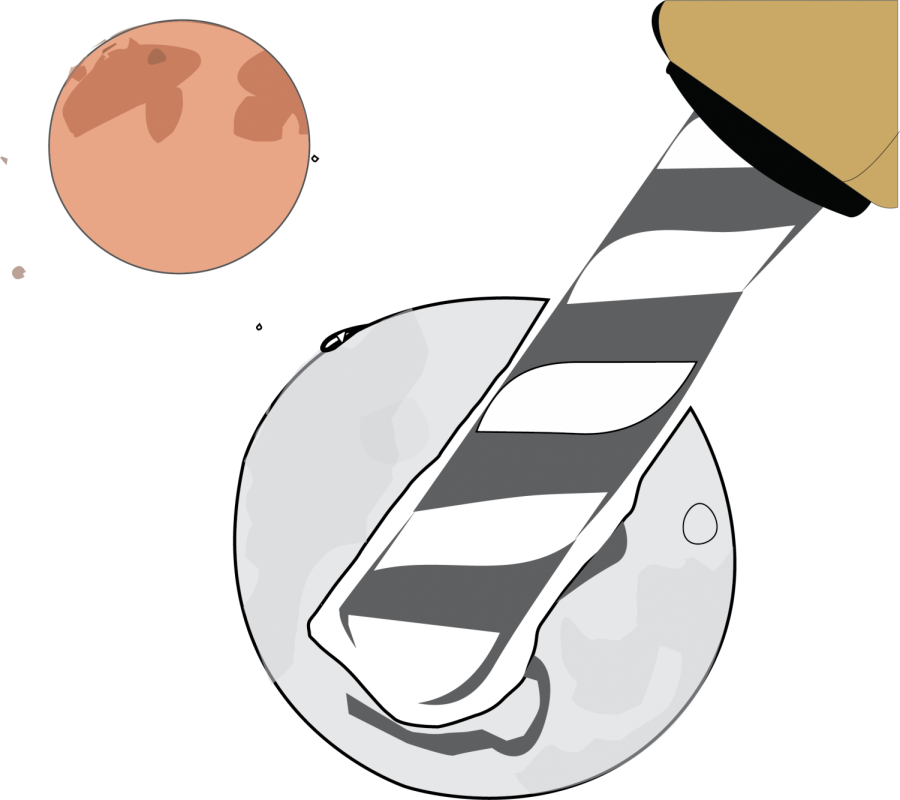Students shoot for the Moon in NASA challenges
February 10, 2021
A team of senior mechanical engineering majors have been busy designing a drill that could be used to drill for water on the surface of the Moon and Mars for a national con-test sponsored by NASA.
The contest, called the “Moon to Mars Ice & Prospecting Challenge,” asks teams of both undergraduate and graduate students “to design and build hardware that can extract water and assess subsurface density profiles from a simulated off -world test bed,” according to NASA’s website.
Todd Letcher, associate mechanical engineering professor and adviser for the team, said that if NASA was to create a base on the Moon or Mars, astronauts would not be able to bring all of the supplies necessary to live on either surface. Therefore, they would need a way to extract these supplies, like water, from the ground.
“On Mars, water is stored in basically large frozen ice blocks underneath a layer of topsoil, and to get to that, you’re going to have to either dig down or drill down,” Letcher said. “Then on the Moon, this machine would be used for prospecting, basically determining what the layers of crust look like on the Moon. The machine has to serve two different purposes.”
South Dakota State University’s team, made up of students Gabe Peters, Matt Dentlinger, Dylan McMahon and Sajan Karki, is one of 12 semi-finalist teams from universities across America. Semi-finalists were announced in December after teams submitted a proposal explaining their designs and how the machines would be used for water extraction and prospecting.
Letcher said that he knew making it to the semifinals would be difficult based on the results of previous years.
“It kind of seemed like it was the same top 10 teams that were getting to the finals every year, so we knew right away that we had our work cut out for us,” he said.
Letcher is also confident in the team’s design and he said the way they have designed the drill itself is what makes it unique from the others.
“Our drill is also our first filter for the water,” he said. “We’re using an inner and outer drill. Our outer drill will stay in the hole for the entire process, and … we’re hoping the outer drill will prevent the hole from collapsing and prevent any sand or rubble from going down in the hole.”
The drill also features a 3D-printed heater core. Letcher says the shape of the heater will promote faster melting, which will hopefully result in more water being extracted more quickly. They’ve named their design the “Jackrabbit Automated Moon to Mars Extractor and prospectoR,” or JAMMER.
Sajan Karki, one of the students on the team, said different team members will focus on different parts of the machine’s design.
“I’m working currently on the filtering side of it, and then I’m going into the heating side,” he said. “Two of our members are working on the drill and one person is working on the controls.”
Semi-finalists received $5,000 from NASA to fund the manufacture of their designs. In mid-March, after reexamining their machines, 10 teams will be selected as finalists and will receive another $5,000 to be used to prepare for the final com-petition in June, where teams will demonstrate their finished technology this June to a panel of judges, including NASA engineers.
So far, the team has spent the spring semester testing the actual capabilities of their design. They have been practicing on frozen five-gallon buckets, though Letcher said they are in the process of building a larger box that can be filled with water and covered with sand and rock to better mimic the conditions the drill will have to face during the final demonstration.
Though Letcher said figuring out the concept and manufacture of the design has been a challenge, he also thinks the team has one advantage when it comes to pre-paring for June: South Dakota winter weather.
“A lot of the other teams are West Coast, East Coast, down south, so they are definitely not testing outside,” he said. “And some of the setups that they have made to try and freeze a large block like that is pretty elaborate, so we’re lucky that we can just go outside.”
In addition to the Moon to Mars challenge, SDSU will be competing in two other NASA challenges this semester with two teams of students. These other competitions are called the “Break the Ice Lunar Challenge” and the “Deep Space Food Challenge.”
The purpose of the lunar challenge is to design a rover and equipment that can extract and move water from the sur-face of the Moon to a populated base. As he says, the way water is frozen on the Moon differs from the way it freezes on Mars, according to Letcher.
“On the Moon, water is stored in tiny little ice crystals mixed into the soil on the surface, so you have to extract the water in two different ways,” he said.
The food challenge asks teams to design a “greenhouse” or other room that can facilitate food production for four astronauts on Mars so they can sustain themselves for extended periods.
SDSU has also taken part in the 3D-Printed Habitat Challenge, also sponsored by NASA, in which teams of both amateurs and professional engineers had to come up with a way to create structures on Mars by designing the material, printer and actual building used. Only two teams have ever finished the challenge, according to Letcher.
Letcher hopes that this challenge will help these students acquire high-paying jobs in the future due to their involvement in the challenge.
“That’s going to look really good on a resume, to say that you won a NASA challenge,” he said. “A lot of the students someday want to work for a big, high-tech company like NASA, SpaceX or Tesla.”
Both Letcher and the students feel confident about their chances come March.
“We are a lot more confident than we were, because it was just a concept at the very beginning, and now we’re actually building it,” Karki said. “It’s coming together, and obviously that helps boost the confidence a lot.”





















